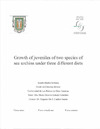Please use this identifier to cite or link to this item:
https://accedacris.ulpgc.es/handle/10553/69537
| DC Field | Value | Language |
|---|---|---|
| dc.contributor.advisor | Gelado Caballero, María Dolores | es |
| dc.contributor.advisor | Carpizo Ituarte, Eugenio De J | es |
| dc.contributor.author | Muñoz Entrena, Sandra | es |
| dc.date.accessioned | 2020-01-31T12:00:56Z | - |
| dc.date.available | 2020-01-31T12:00:56Z | - |
| dc.date.issued | 2020 | - |
| dc.identifier.uri | https://accedacris.ulpgc.es/handle/10553/69537 | - |
| dc.description.abstract | The general observation that organisms are adapted to their environment lies at the foundation of biology (Yokota et al, 2002). The evolutionary and ecological framework implies to the organism a suite of adaptative responses (biochemical, physiological, behavioural) which together enable it to survive and to reproduce within a particular set of environmental conditions (Yokota et al, 2002). Marine coastal habitats are characterized by high environmental variability. It is believed that, due to adaptation or acclimation to natural environmental variability, intertidal species may have some capacity to recover from future changes (Yokota et al, 2002). Urchins are considered keystone species in ecosystems as their Aristotle’s lantern is adapted for biting, tearing and scrasping and can even function to grab the substrate. They are herbivores although, some of them, in particular situations they behave like omnivores. The regular echinoids seem to have the widest spectrum of food types included soft-bodied organisms (plant and animals), hard surfaces (rock with incrusting or boring plants and animals) or hard animals (corals and bivalves), and soft substrate. The present study focuses on evaluating the effects of three different diets (the giant kelp, Macrocystis pyrifera, a formulated food and combination of both) on the growth of two species of juvenile sea urchin (Lytechinus pictus and Arbacia stellata). Both species are inhabitants of the Pacific coast of Baja California, with A. Stellata increasing their range extension to the north, due to the more common presence of warmer ocean waters in front of Baja California. For this purpose, measurements of weight and size of the organisms, were made every 15 days for three months. Aditionally, temperature, pH, oxygen, sea water flow and behavior of the sea urchins were monitored. In the present study we use M. pyrifera, since is an abundant natural food resource in Baja California used by different species of sea urchins. We also used a formulated mircoencaspulated diet because was expected to have a positive effect on the growth of sea urchins in captivity. Knowing the growth response to different diets of these common especies in Baja California, will help us to conduct future studies to understand its posible interaction in the ocean and predict posible impacts of the increasing presence of A. Stellata along the coast of Baja California. | en_US |
| dc.language | eng | en_US |
| dc.subject | 240119 Zoología marina | en_US |
| dc.subject.other | Sea urchins | es |
| dc.subject.other | Arbacia stellata | es |
| dc.subject.other | Lytechinus pictus | es |
| dc.title | Growth of juveniles of two species of sea urchins under three different diets | es |
| dc.type | info:eu-repo/semantics/bachelorThesis | en_US |
| dc.type | BachelorThesis | en_US |
| dc.contributor.departamento | Departamento de Química | es |
| dc.contributor.facultad | Facultad de Ciencias del Mar | en_US |
| dc.investigacion | Ciencias | en_US |
| dc.type2 | Trabajo final de grado | en_US |
| dc.utils.revision | Sí | en_US |
| dc.identifier.matricula | TFT-51947 | es |
| dc.identifier.ulpgc | Sí | en_US |
| dc.contributor.buulpgc | BU-BAS | es |
| dc.contributor.titulacion | Grado en Ciencias del Mar | es |
| item.fulltext | Con texto completo | - |
| item.grantfulltext | open | - |
| crisitem.advisor.dept | GIR Tecnologías, Gestión y Biogeoquímica Ambiental | - |
| crisitem.advisor.dept | Departamento de Química | - |
| Appears in Collections: | Trabajo final de grado | |
Page view(s)
159
checked on May 18, 2024
Download(s)
124
checked on May 18, 2024
Google ScholarTM
Check
Share
Export metadata
Items in accedaCRIS are protected by copyright, with all rights reserved, unless otherwise indicated.
